Cutting & Drying Fish

|
Traditionally, fishing has been the core of subsistence life throughout most of Alaska. Oldtimers always said, “Fish as if you wouldn’t catch any animals all winter. Then if you do catch something, you will do well. If you don’t catch any animals, you will get tired of fish, but you won’t starve.” Until recently, there were no freezers and people had to find ways to preserve the fish they caught. Oldtimers made drying fish an art form. Some families made better fish than others, but all families recognized the life and death issues involved in putting fish away for the winter. Many of the same principles involved in drying fish also apply to drying moose, caribou, seal, and other meat. |
||
|
The Opposition
One of nature’s purposes for blowflies is to consume spawned out salmon so their dead bodies won’t contaminate the river for the whole summer. Blowflies and the resulting maggots can remove a whole fish in only a few days. There are more blowflies upriver than downriver because their purpose is naturally fulfilled at or near the spawning ground. Downriver people have much less problems with blowflies than upriver people. Many people on the coast of Alaska don’t use a smokehouse. There are fewer flies and more wind. However, fish hung in the open must be protected from seagulls and ravens. In Southeast Alaska, people use more smoke and heat as damp conditions promote rotting. |
||
|
|
ObjectivesOur objective is to put food away when there is an abundance so we might eat in times of lack. There are three ways of preserving fish:
|
||

|
ConditionsThere are a couple of conditions necessary for fish to rot:
Blowflies There are two conditions necessary for blowflies to reproduce on the fish.
Some people leave their fish outside for the first day or two to get a good dry crust on them and then bring them inside the smokehouse. Other people bring their fish straight to the smokehouse. Many people soak the fish in salt and/or sprinkle them with pepper to keep the flies off the fish. Salt and pepper add to the taste after the fish is dry. Compromise There is a delicate balance between smoke and fresh air. Many smokehouses have doors and vents that can be opened or closed to control that balance. If there is a lot of fresh air around the fish in the smokehouse, they dry fast, but it is hard to keep smoke around the fish. If there is lots of heat or smoke, and no fresh air, the fish can sour or even cook. Rotting is slow. Blowflies are fast. I tend to err on the side of slower drying with adequate smoke. |
||

|
Smokehouse RoofSmokehouse roofs often have a rather shallow pitch to hold smoke down around the fish. Since blowflies need wet or damp fish to lay their eggs, a good smokehouse roof is most important. A leaky roof brings them a banquet. Days later the sun might be shining, but inside the smokehouse it could be raining maggots! Even fish that were once dry can become maggot infested if rained upon. Once they have infested a fish, it is not likely to dry. Smoke repels mature blowflies but not maggots. People have tried screening in their smokehouses to keep the flies out. This helps a little, but blowflies have an amazing ability to crawl through cracks. Few people who have screened once, try it again. Near the ocean, a steel roof will drip rusty condensation on the fish. |
||
|
|
Temperature and MaterialsFish need to be kept cool or they will rot. A hot smokehouse creates sour fish. Steel siding absorbs and conducts heat, making the smokehouse very hot in the sun. Much better are plywood, lumber, spruce-bark slabs, or spruce-bark sides. Spruce bark is wonderful. It is cool, and allows a gentle flow of air through the knot holes and other cracks. It is not very durable and definitely not bear proof. Skill is required to remove the bark from the tree in usable pieces. Ask the local elders how it is done. |
||

|
BrushWhen oldtimers were trying a new place to fish, they didn’t want to spend a lot of energy building a smokehouse until they found out if the location was good for fishing. For a temporary smokehouse, they put poles on the sides of the smokehouse and wove brush in and out of those poles. This is an easy and effective way to keep smoke in, but after the brush dries, it is a real fire hazard. I made a smokehouse with brush sides once and was very satisfied. However, the second year, when the brush had dried, it became a firetrap. |
||
|
|
LocationFish cannot become drier than their surroundings. Damp ground makes damp fish. Most smokehouses are on top of a bank so they can catch a gentle breeze as it blows up and down the river. If the smokehouse is by a creek in a narrow valley, the fish will be damp because of the closeness to the creek. The drier the ground, the better the fish will be. Some oldtimers located their smokehouses on small hills beside the fishing site so the fish could dry well. This meant carrying each fish up the hill, but it was worth the effort. Most people cut brush and grass surrounding their smokehouses to increase the air flow and to remove where bears might hide. |
||
|
|
WeatherThe weather has a great effect on the fishing operation. If the fish isn’t dry and put away before wet weather arrives, they are apt to mold. In our region, silver salmon are seldom dried because they arrive during the wetter part of the summer. If the weather is damp, fish cutters make the blanket fish and strips thinner to dry faster. One time I cut eating fish too thick, not wanting to waste any. I ended up wasting a lot of fish because it became sour before it dried. Smudge Wood and Weather Many people like to use alder or cottonwood to smudge the fish. During cold, damp, and rainy weather they use birch because it provides a small amount of heat and helps dry the fish. Birch also adds a different flavor. Very few people use spruce. |
||
|
|
The SecretThe secret is to keep flies out while providing as much dry, cool air as possible. Making good dry fish is the result of knowing the fish, the weather, and the environment surrounding the smokehouse. Oldtimers were, and still are, very particular and very proud of their fish. |
||

|
Cutting FishThere are many factors that determine how we cut and prepare dry fish.
Imagine two wet towels. One is rolled up and hung on the clothes line. The other one is spread wide and hung on the same line. Which one will dry faster? The one that is spread out will dry faster because it has greater surface area exposed to the breeze. The same is true for fish. The more surface area we can expose, the faster it dries. The traditional way is to cut the flesh away from the backbone and ribs, and score the fish many times to create folds of flesh that hang exposed to the smoke and breeze. In Southeast Alaska, the weather is so damp, fish is cut thin and often put on wire mesh racks and smoked strongly with considerable heat. It is more of a kippering process than drying. Dog feed vs. eating fish A salmon has five sets of bones. The main difference between eating fish and dog fish is that eating fish (for people) don’t include the rib bones. It takes more time and care to separate the meat from the rib bones, but the time is well spent. Balance Whatever cutting style is used, care must be given to ensure that both halves weigh approximately the same. If one side is heavier than the other, the fish will constantly slip off the pole. A Refinement If the fish cutter scores the fish down at an angle, it allows moisture a way to run off. |
||
|
|
FishraftsMany families who fish use a fishraft that is tied to the riverbank. They are a good place to store fish and make a convenient, clean place to cut fish. Many people have a fish table on the raft. This saves the backbreaking effort of bending for hours at a time. Many people put gunny sacks, spruce bark, or plastic welcome mats on the surface of the table to increase friction with the very slippery fish while they are being prepared. They are easily cleaned by dipping and scrubbing in the river. Most people use wire mesh between the logs to hold the fish. Moldy fish heads that have been in the fishraft for over three to four days are ready to feed to dogs. Fresh salmon are indigestible and make the dogs sick. |
||
|
|
Fishpoles I can remember nailing one fish to the pole; I was so frustrated having to hang it up again and again. Later I learned to put grass between the pole and the fish. This increased the friction between the two and actually dried the fish on the point of contact. Spruce poles are rough enough to hold most fish from sliding. |
||
|
|
Upriver TrickFish caught downriver are in good shape—fat and silvery in skin color. Fish caught upriver are very lean. They often dry out brittle and hard to eat. One trick upriver people use is to leave the fish in the fishraft overnight. They must be under water. The enzymes in the fish soften the meat and make the fish better eating when dry. However, this method makes them prone to sour and should only be done in good weather. Sometimes people leave the fish in the raft overnight because they are lazy. Special care must be given to fish or they will easily sour. |
||
|
|
|
||

|
Activities
|
||

|
Student Response
|
||

|
Math
|

 There
is opposition to those who attempt to dry fish:
There
is opposition to those who attempt to dry fish:
 There
are many techniques for cutting fish. Everyone has their own method.
The main thing is to cut the fish so it can dry quickly by exposing
as much surface area to the air.
There
are many techniques for cutting fish. Everyone has their own method.
The main thing is to cut the fish so it can dry quickly by exposing
as much surface area to the air.

 Sometimes
the fish are too slippery to stay on the pole, particularly if the
fish aren’t balanced.
Sometimes
the fish are too slippery to stay on the pole, particularly if the
fish aren’t balanced.
 Storing
Dry Fish
Storing
Dry Fish